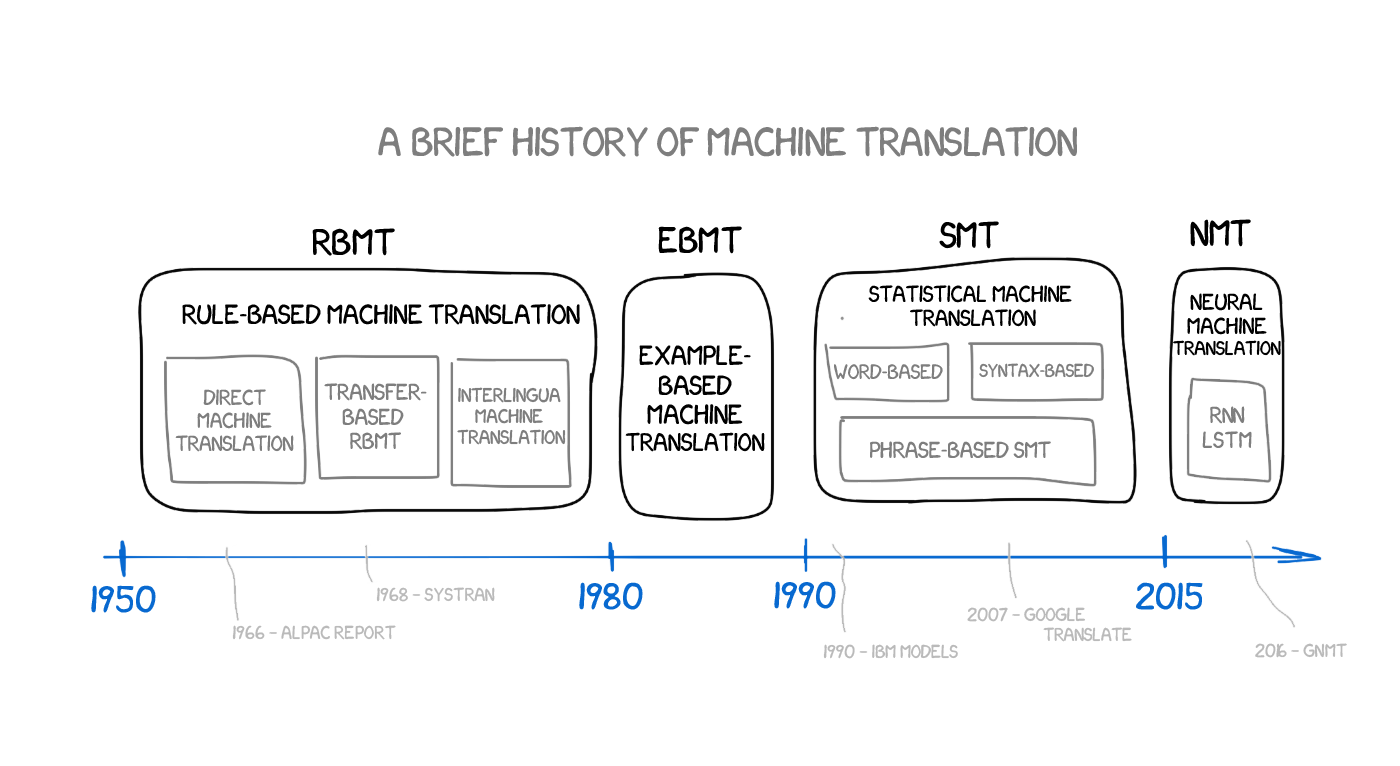When the word “evolution” is used, it typically implies a slow and steady progression from something simple (like a one cell organism) to something infinitely complex (a product marketer). When we talk about the evolution of technology, timelines tend to be more compact and sprints of innovation typically transform what is possible. Similarly, there are technology disruptions – such as the entry of the Uber model -- that change customer expectations and force transformations.
Sprints of innovation
Machine Translation technology has experienced sprints of innovation. From initial Cold War experiments with English to Russian at Georgetown, and subsequently with Russian to English in the Soviet Union, to the multilingual virtual assistants of today, developments and disruptions have changed what Machine Translation is capable of delivering in a business environment. Here's a quick snapshot of how MT has evolved in recent years (
source).
Welcome to neural machine translation technology
The biggest disruptor was the move from Statistical Machine Translation (SMT) to Neural Machine Translation (NMT), which happened because computing resources evolved to accommodate faster processing and significantly less expensive data storage for content-hungry MT. Computer processes that took days to complete were now executed in minutes, if not seconds. Consider that in 1990 our personal PC came with 1 gigabyte capacity, whereas today’s PC can handle 1 – 6 terabytes – and the price of today’s PC is likely much cheaper. Faster processing, more storage, lower costs, the growth of data science and an increasing interest in all things AI means that the pace of technology innovation is ever-increasing.
RWS has capitalized on these technology trends by offering innovations to improve what our customers can do with our Machine Translation technology. RWS has been able to improve its own NMT capabilities by 25% within a single year, and, with a nod to the language pair that was the single cell organism,
broke the quality barrier for Russian to English in 2018 by achieving 95% accuracy. However, while significant, this single achievement does not represent an evolution to a more complex system.
New requirements for machine translation software
Machine Translation evolution means that MT software needs to deliver a more complex set of requirements than automatic translation. This software needs to:
- Seamlessly fit into a complex business environment
- Break language barriers across an increasing set of use cases
- Have a positive impact on relevant business outcomes
- Be built as a business essential, not a commodity
The last point is the most important. Often, MT software is delivered as a basic capability that a developer can fit into an end-used business application or a translator can tap into as a productivity accelerator for manual document translation. Both of those scenarios are absolutely relevant when thinking about MT as a capability. But when we think about Machine Translation software, we need to think bigger. After all, this software can remove language barriers for key business areas such as:
- Internal Communication and Collaboration: Machine Translation can enable an organization to collaborate across languages, ensuring every business decision is made with a global perspective and real understanding.
- Customer Service: Personalized customer service has been shown time and again to be the lynchpin for an outstanding user experience rating - and language is the most personal dimension there is.
- Business Intelligence: 80% of data is unstructured. Gaining a global perspective means being able to leverage all the languages that the unstructured data represents, not just the one your analyst happens to be fluent in.
- eDiscovery: A global perspective is increasingly difficult to manage in a business world where storage is virtual and the volume of content is massive.
Evolving definitions of machine translation business value
For a commodity capability, the only requirement is that it works. For MT as a commodity, this means the automatic translation delivered is an accurate translation of a word, phrase or document. Accuracy or quality is usually measured by how closely the automatic translation resembles the translation produced by a human. Typical translation workflows often implement a human-in-the-loop feature to ensure there is a review and/or correction cycle and the automatic translation has human oversight. Machine Translation software may include that feature. Our recently released RWS Machine Translation Edge software includes interactive editing, which captures corrections and feeds them back to the system as a learning.
While accuracy is important, it should not be the sole yardstick used to measure MT software. When considering business areas for Machine Translation, following are outcomes that may be evaluated and the role MT software plays:
|
Business Area:
|
Internal Communication & Collaboration
|
Customer Service
|
Business Intelligence
|
eDiscovery
|
|
ROI Elements:
|
- Percent fewer calls to free services
- Engagement in communication
- Volume of cross-border communication
|
- Number of languages offered
- Number of customers served
- Customer satisfaction
|
- Percent of unstructured data included in analysis
- Time spent on data preparation
- Cost of data preparation
|
- Time savings vs. manual translation
- Number of documents processed
- Customer satisfaction
|
|
Role of MT Software:
|
MT software replaces unsecure and often unapproved use of free online translation utilities. It also makes communication more accessible to a broader set of employees and allows those employees to communicate with each other.
|
MT software allows organizations to implement more languages across more channels (web, email, chat, virtual assistant) to serve a bigger customer base. Research shows the importance of language and customer satisfaction.
|
MT software allows the analyst to leverage a broader data set with more languages in their analysis without investing time to get the data translated by outside resources. This reduces costs and the overall analysis timeline.
|
MT software allows organizations to accelerate their responsiveness and handle a larger set of documents than through manual efforts alone. This automation reduces costs and compresses timelines, increasing customer satisfaction.
|
So... what’s next for MT?
Predicting what’s next for technology is always difficult and bound to be inaccurate. The overall technology trajectory is to go beyond routine automation and use AI to create smarter software. For RWS, it means making MT software smarter through Linguistic AI™ (we call it “Hai”). Linguistic AI™ learns from key content insights that may be used to improve how MT is applied and may broaden MT’s use cases beyond those already addressed. As the world becomes more interconnected, we need to break down language barriers wherever we find them and the only way to do so reliably, at the scale and speed of business, is through MT.
If you'd like to learn more about RWS's machine translation technology, and why we've been at the forefront of MT innovation, click here.


